Having recently restored one of Aquastar’s first Regate models, when the chance came along to pick up a later version, I took it…
(Click pictures to enlarge)
The watch arrived in pretty much the same condition as the last one, cosmetically reasonable, but it would only tick for a few seconds and the sailing timer function didn’t work.
This model was first introduced during the 1970’s and added an extra function to the original version; timing for both periods of the countdown, showing blue dots for the first five minutes and red dots for the second. (I explained how to use a sailing timer in the previous Regate post, click here if you missed it).
The movement inside this one is a Lemania cal. 1345. It is based on the cal. 1341 cam lever chronograph used in some of the Omega and Tissot chronographs from the same period, but with a sailing timer in place of the chronograph mechanism. It has a uni-directional automatic winding mechanism and it ticks at a rate of 28,800bph.
The most interesting part is obviously the sailing timer, here’s a description of how it works…
Removing the dial reveals the countdown disc with the two coloured sections for the timer…
Underneath this is the timer mechanism where the chronograph parts would be in a cal. 1341…
(Click picture to enlarge)
The picture on the left shows the timer mechanism in “stopped” state. (I can’t find the official names for these parts so I’m going to have to ‘wing it’, hopefully it will be understandable!) The rack sits at its upper limit, pressed against the stopper by the spring underneath. The rack also holds the timer wheel steady and away from the power source. If you look closely you can see that the timer wheel is disconnected from the intermediate wheel at this point. In this state, the holes in the dial show all silver.
The picture on the right shows the mechanism in “started” state, i.e. after the pusher has been pressed. The rack turns until it hits the stopper, turning with it the timer wheel on which the countdown disc sits. The timer wheel now engages with the intermediate wheel. In this state, the holes in the dial are now all blue.
With the rack removed you can see the power source for the mechanism, a driving wheel attached to the elongated third wheel axle. Two intermediate wheels transfer the power from the driving wheel through to the timer wheel…
All three of these wheels turn constantly if the watch is running, so when the pusher is pressed, the second intermediate wheel has to be disengaged from the timer wheel to allow it to rotate freely. To achieve this, the two intermediate wheels are mounted on a spring loaded rocker. When the pusher is pressed, the disconnecting lever moves the second intermediate wheel away from the timer wheel and the rack turns it to the “started” position.
On releasing the pusher, the second intermediate wheel springs back into contact with the timer wheel and the timer is now running. For the next ten minutes the power provided by the driving wheel turns the timer wheel back to the “stopped” position, rotating with it the countdown disc under the dial.
On the other side of the calibre, with the winding rotor removed you can see the reset mechanism…
When the pusher is pressed, the operating lever performs two functions. Firstly, it pushes the cam which lifts the coupling wheel from the centre wheel, and also pulls the connecting rod to turn the rack on the opposite side of the movement. Secondly, once the coupling wheel is disengaged from the centre wheel, the second hammer moves across resetting the second hand back to zero to the start the countdown.
I took a bit of gamble on this watch as parts would have been hard to track down, but thankfully, nothing was missing or broken. The timer mechanism had just been assembled incorrectly, so once I figured out how it worked and set it up correctly, it worked perfectly.
With the timer problem solved and the movement cleaned and oiled, I relumed the hands, repainted the faded second hand and fitted a new crystal. Here’s the result…. all I need now is a yacht!
Rich.

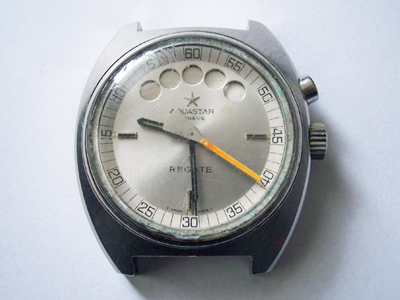
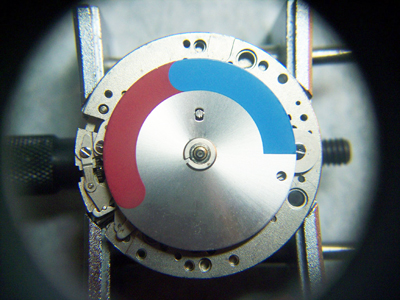
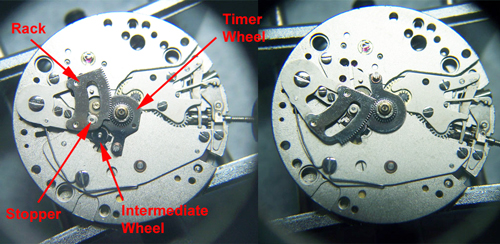
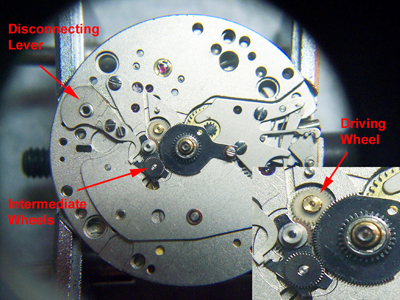
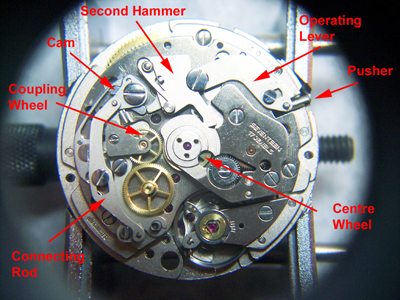
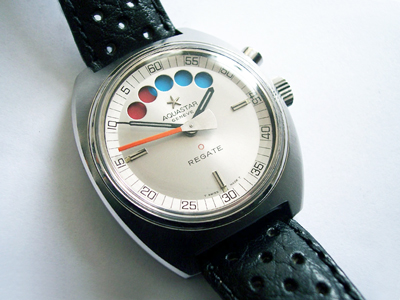
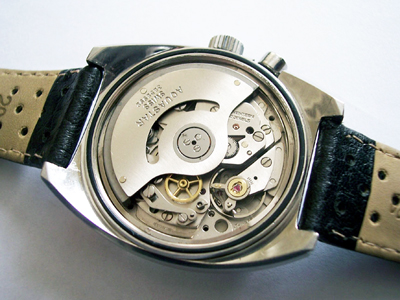
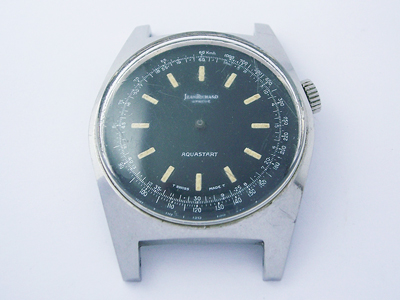
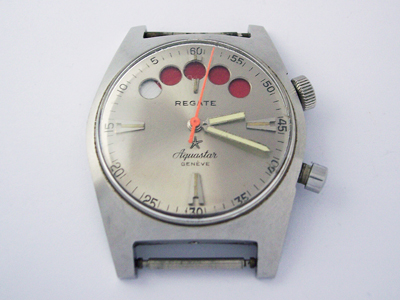
Hi,
Thank you for the article. Very ediuational.
This is some time ago, but I give it a try. I have a nice Automatic-ChronoAquastar with Lemania Cal.1345 housing. (I think.) It is now overhauled, but we could nor find a suitable glass, so I am stuck with a very curved non original. Does anybody know if it is possible to find a reasonably suitable?
I purchased a Tissot Regate back in 1980 which I used daily when yacht racing .
A great watch that kept great time. It sat in a draw for over 10 years. Unfortunately in 2004 I went swimming with it on and water got in. I was told at the time it could not be repaired. I have recently found it and movement does not look to bad. (dial and glass pretty stuffed)I am in process of taking to good watchmaker to see if it can be reserrected.
I bought my Regate new in the 1970s when I was racing Olympic Tornado catamarans, it’s been a great watch & still works fine although I rarely use it now.
Yesterday I bought a Heuer Regatta, the black one.
It was in someones vault for 30 years and was never worn; it’s mint….
Do I feel the luckiest guy in the world to be able to purchase this beautifull watch?
YES! 😉
There is a store “Best Wind” in Malcesine (Lake Garda) which has one of these watches with the Elvströn design.
I had a Tissot Regate Aquastar from the late 70’s till it ceased to function in the late 90’s. Used it three days aweek is sailing starts and surf board competition during the time i had it.
Found a watch maker who could fix it but he could not source the necessary parts to make the start function work, he purchased the watch from me for a good price.
I wish I could buy another just like it.
Best watch I’ve ever had.